With each new hike that I embark on, I need to do research, so to understand the risks involved. Here are my steps to finding information, reducing the risk factors and making hiking with your dog a safe activity.
Like all outdoor activities, hiking with a dog does have some risks, however by knowing the risks and keeping your dog leashed, you can dramatically minimize potential danger so that hiking with your dog is safe and enjoyable activity.
Hiking with your dog can be the most rewarding experience that promotes a strong bond and puts you both in tune with nature out on the trails. However, there are some risks involved which need to be addressed to ensure that you and your dog are best prepared for the hiking season.
If you and your dog are new to hiking or you want to brush up on your knowledge then you will benefit from the research below. Here are some considerations and aspects to look out for while researching for your next hike.
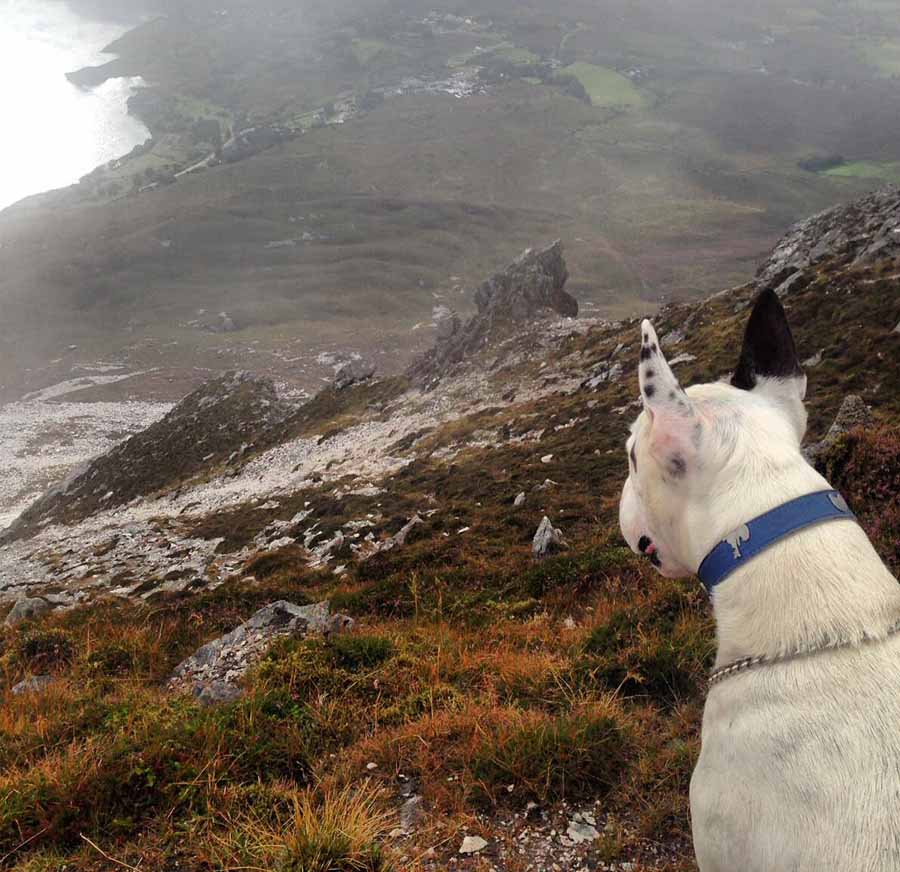
Your Dog’s Fitness Level
First and foremost, be realistic about your own dog’s ability and fitness level. If you haven’t done hiking before or it’s been a good few months away from the trails. Then choose an easy hike to start with. Alternatively, build up your dog’s endurance first in the comfort of your home community before testing this out on the trials.
See ‘A Simple Guide to preparing your dog for the hiking season’ to be best prepared for the trails.
Pick an easy rated trail that takes one or two hours. Do these types of hikes first before picking something that is more adventurous, just to see how you and your dog will go.
Age of Your Dog
What is the age of your dog?
I would not take a puppy with me hiking, unless you are prepared to carry them most of the way and if it is a super easy hike that is close to the car. I would wait until the dog is at least 1 year old and for large breeds its best to wait to at least 1 and a half years of age before embarking on a decent hiking trail.
The reason for this is that hiking can be strenuous on a dog’s joints as the ground is not always flat. It’s better to wait when the dog has finished growing so the hike doesn’t put too much strain on your dog’s limbs.
For older dogs, I would go on hikes that are short such as one or two hours long. These ideally would be close to the car, really easy hikes with lots of tree shade. Also, I would only take a dog that I could carry back to the car, just in case something was to happen.
Your Dog’s Breed
Being out on the trails and hiking with many other canine hiking buddies, I have learnt that all dogs love to be with their owners on the trails regardless of the size or breed of dog. Being in a completely new and natural environment engages your dogs scenes with new smells, sights and sounds.
However, there are some limitations to some dog breeds that may not be as obvious to you. For these dogs breeds below I would recommend shorter easy hikes of one or two hours that are not as strenuous on the dog’s body.
Below I have outlined the breeds that may benefit from easier hikes so you can pick the right hike for you and your dog.
Brachycephalic Dogs
As with all dogs, heat is expelled through panting and not sweating like humans. The shorter noses of Brachycephalic dogs limit their ability to breath and expel the heat at a slower rate than normal. This makes it harder for the dog to breath and to cool down. These dogs can experience heatstroke quicker.
Such breads include: Bulldog types, Pugs, Pekingese, Shih Tsu, King Charles Spaniel, Shar Pei, Staffies, Boxers, English, Bull and Neapolitan Mastiffs

Heavy Set Dogs
Heavy set muscular dogs that have a large build in a higher proportion to their overall size can be at disadvantage on the trials because they won’t be as nimble or as athletic as most other breeds. These dogs may experience joint and bone problems if exposed to too much strenuous activities over time.
Such breeds include: English Bulldog, American Bully, large Staffies and Am Staffs and basset hounds. Also dogs that exhibit wider proportions then the breeds standard would also fit into this list.
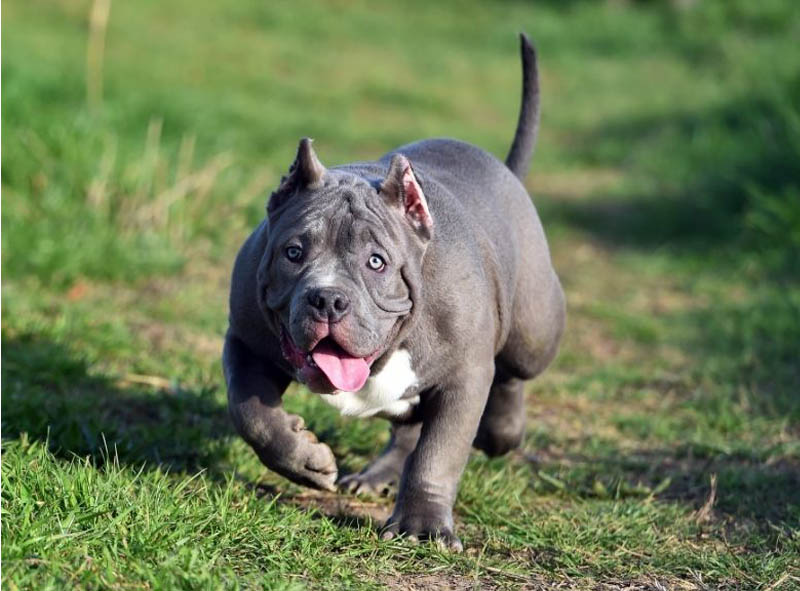
Large & Extra Large Heavy Breeds
In addition, most of the extra large guarding breeds would also do better on shorter hikes as they could get tired more easily. In modern times, these dogs typically are bred to guard and not to walk or run on the hunting trials or herding fields.
Such breeds include: Great Dane, Tibetan Mastiff, Bull Mastiff, Bully Kutta, Dogue De Bordeaux, English Mastiff, Pyrenean Mastiff, Fila Brasileiro, and Spanish Mastiff to name a few.

Small Dogs
Small dogs are great to hike with. Due to their size they do get tired more easily and it is harder for these dogs to traverse over difficult terrain. However the advantage to hiking with a small dog is you can pick them up and carry them over obstacles or support them when they get tired. You can even buy dog carrier backpacks which are great for small dog owners. See here my link to the best dog carrier backpack which is the K9 Sport Sack.
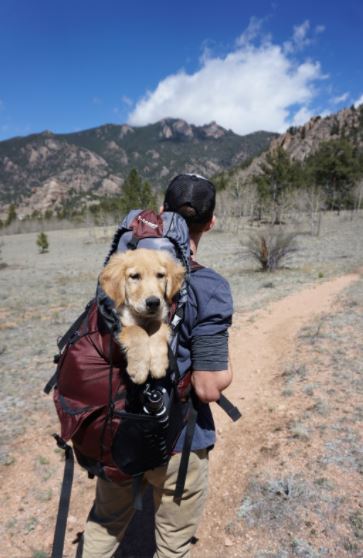
Tags ID / Medications & Vaccinations
Before embarking on any hike, be sure to have your dog’s microchip information updated with your local vet, check all vaccinations are up to date and that preventative medication for worms, flea and ticks has been given. (not on the day of the hike). For extensive list to cross check with your vet and also see ‘A Simple Guide to preparing your dog for the hiking season’
Training
Training your dog is an ongoing task that you should maintain throughout your dog’s life. By doing this your dog will respond to you better and likely listen to you out on the trails. Brush up your basic obedience training prior to any hike and such commands as Leave it, Wait, and practice your Recalls. Practice with your dog sitting and waiting before going through doors, hopping in and out of the car and before receiving meals. Having this basic level of training will be very beneficial when you are out on the trials and you need your dog to listen to you which will keep him safe.
Heat stroke
Heatstroke in dogs is very common on hot hiking trails. Signs of heat stroke include:
- Excessive panting
- Breathing noises
- Drooling
- Reddened gums
- Vomiting
- Diarrhea
- Dullness
- uncoordinated movements
- Looking to rest and finding shade
- Collapse
What to do if you think your dog has heat stroke
- Take your dog out of the hot environment
- Splash water over them and under their belly and chest
- Let your dog drink as much cool water as they want without forcing it.
- Take them to the vet
To minimise the risk of heat stroke go hiking in the very early hours of the morning or late afternoon. And avoid hiking in the middle of the day.
I always carry the same amount of water as I need, for my dog. The general rule is that you will drink half a litre of water per hour. In hot environments you will drink one litre of water per hour. It’s always best to carry more water than you need because it is better to have more than to have without.
Also keep some water in the car for when you return.
Using this general rule and going on some easy short hikes with your dog you will get to know your dog’s water needs. Most likely your dog will drink less than what you will consume however you must allow for the splash factor of the wasted water when your dog drinks.
Take lots of breaks in the shade and notice how long it takes for your dog’s breathing to begin to be normal before heading further along the trail.
Cuts to paws
I find that the most common issue when hiking with a dog is cuts to their paws. Once they have a bad cut to the paw they will likely not walk. This could be a problem if you have a heavy or large dog.
I always take a dog booties and duct tape with me if the ground is very rough then i’ll use the booties. If the ground is soft, I may then just take a boot in the bag in case he does cut his paw and I need to bandage it and then protect the bandage with the boot on. Often if there is some padding to the wound your dog may still walk.
Cuts to the paws can come from jagged rocks, debris, rubbish, thorns and cacti. Hot ground can also wear down the soft tissue of the paws. Be sure to take your dog booties every time you go hiking. Adding a protective product such as Mushers Secret to the paws I find has helped keep his paws in good conditions. Here are the booties I use as they have extra grip then most and stay on better than others that I have tried – Outdoor Dog
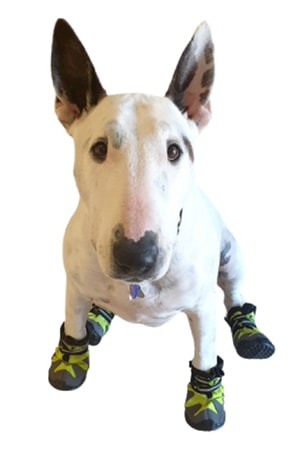
Your Chosen Hike
Go on trials that hikers have listed as easy. If you and your dog are experienced hikers, then you should be able to manage a median hike. But do your research of the trial first. You can find this information on local hiking blogs or Park websites.
From previous experience, I believe that no dogs should be on any trial listed as hard.
Hard trials often have very technical terrain and may include river crossings, ladders, roped sections or precarious ledges. There have been fatal accidents where dogs have fallen off ledges and cliffs. These environments are not suited for your dog.
I have made the mistake of going on a Hard listed trail to find a section of steep rock that my dog could not cross. We had no choice but to go back and not complete the trail. Believe me you will enjoy the hike so much more if you pick something that you both can do and complete together.
Animals To Watch Out For
Coming across animals in the wild can happen from time to time. Most animals will keep away from the trail and will either hear you coming. Most animals will also avoid dogs as much as possible.
If you keep your dog on a long leash and allow them only to stay with you on the trail your risk of animal encounters will dramatically reduce. it’s very important to keep your dog leashed as many animals jump out of the scrub and dart across the trial. This sudden movement can trigger your dog’s prey drive and they will want to chase without even thinking about it.
Having them leashed not only stops your dog from getting into an altercation with a wild animal but it will also prevent them from running off into an unsuspected environment, such as cliff edge, swamp or thick thorny shrubs for example.
Ticks
Your biggest threat to your dog in regard to other animals are ticks. Before going on the trail find out if it is tick season and what tick diseases there are in your area.
This information can be quickly found out by a call to the closest vet to your hike. This is a good practice to get into, as you would establish where the closest vet is located.
Another nastiness about ticks is that they can carry diseases that can affect you and your dog. Signs of the disease may not appear for 7-21 days after the tick bite. Such issues can cause skin infections, anaplasmosis, ehrlichiosis, rocky mountain spotted fever and lyme disease and tick paralysis. Some of which can be fatal.
Paralysis Ticks – Australia, USA, Canada, Southern Africa, East Mediterranean and India
Signs include wobbliness in back legs, difficulty breathing, vomiting, change in bark and coughing. Take your dog to the vet, even if you have removed the tick.
Personally, I hate dealing with ticks and I prefer to wait for the colder months of the year to hike in areas that are known to have ticks. Even in cooler months of the year in these areas I would still use the precautions below to be best prepared.
- Stick to the trial and don’t let your dog jump through long grass.
- Apply flea and tick precautionary medication a few days prior to the hike
- Put a tick collar on your dog in tick prone areas.
- Apply a dog safe insect repellent to your dog’s coat
- Carry a tick removal tool
- Check your dog often by rubbing your hands over your dog coat and looking especially around the tail, ears, eyelids, under the collar, in between the legs and in your dog’s paws.
- If you see a tick, remove it straight away either by tick removal tool or fine tipped forceps. Avoid squeezing the body of the tick
- If you find a tick on your dog and remove it and wash wound with povidone-iodine Betadine
- If you are in areas with Paralysis tick go to the vet after tick removal.
Plants
Plants pose more of a risk to dogs if they can run off the trail and into the thicket or scrub. It is advised to keep your dog with you on a leash. Plants such as poison ivy, poison oak, sumac, nettles, lacquer trees, Rhus trees, Caster Oil Plant will cause irritation and rash to you and your dog and are best avoided. If you are on a well walked trail you should be ok.
Don’t let your dog chew on any plants. All plants should be considered toxic if eaten, unless it is a fruit, vegetable or herb that you know of.
Plants with thorns, barbs and hooks often get attached to your dog’s fur and paws. Most of the time your dog will stop and lift the paw with the thorn for you to remove it.
Traps and Baits
Wildlife traps and bait are also something to look out for. This is another reason to always keep your dog on a leash. At the trailhead there should be signs stating that there is baiting and traps in the area. Often this will be in areas that are closely located at the trailhead or alongside roads. In some countries they have a trapping and baiting season, it’s best to find out when this is.
Traps
If your dog does get caught in a trap, place your soft muzzle over the dog as they may bite you or others due to the pain. Figure out the trap mechanism and understand how it works first before trying to release the dog. Spending a few moments figuring out the mechanism is vital as you will work out how to release your dog properly and not cause further injury.
Here is a link to a common traps scenario and how to release your dog.
Baits
If your dog eats bait, you need to contact your vet immediately and do not wait for signs of symptoms. Depending on the bait you may only have 30 minutes to receive the antidote. Try to induce vomiting however there is a strong chance that it will be fatal.
This is so important that if you see signs at the start of the trail that there is baiting in the area – Immediately leave.
This has happened to me and I travelled for 2 hours by car to get to the trail only to find that there was fox baiting in the area. It is safer to choose another place or go home then continue into the area where your dog could possibly pick up and eat the bait.
Water Borne Diseases
Don’t let your dog swim in any stagnant water bodies and Don’t let your dog drink any water in streams, puddles or lakes. You should carry all of his water for the hike. There are many bacteria and parasites that your dog can get and even pass it to you.
Leptospirosis, pythiosis, Blue Green Algae, Giardia, Cryptosporidiosis, worms and pseudomonas are just to name a few.
If you wouldn’t swim in the water, then neither should your dog.
Don’t let your dog eat anything off the ground
Dogs love to sniff and will even try and eat anything that they think is edible. This may even include dead animals. However, you should always avoid your dog eating anything off the ground as it could contain disease, parasites, canine plague, fleas or have previously been baited.
Keep your dog leashed and train your dog on the words ‘Leave It’
See more instructions on this in A Simple Guide to Preparing Your dog for the hiking season.
Cliffs and Ledges
There are many hikes that I have done that have been listed by other hikers as medium where there have been some precarious sections that contain a sudden drop to one side.
If the path is wide enough for both of you to fit side by side with ample room and your dog is calm, trained and leashed then you can proceed with caution. I would only attempt to go on trials listed as medium with a dog who has been hiking before and can follow my commands.
These environments are not for overly excited dogs or for dogs who will want to test your authority.
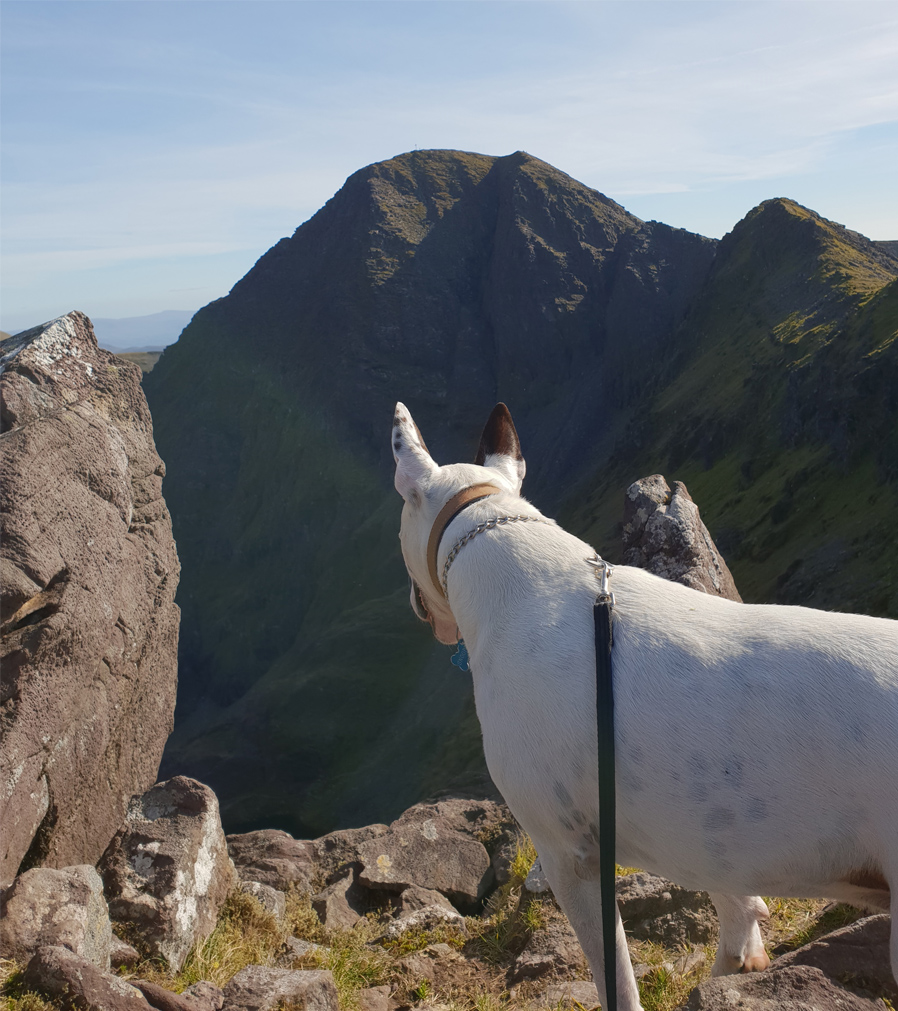
Traveling in these sections your dog should be either right beside you or behind you. They should not be in front of you leading the way. When a dog is in front leading the way they are acting like the leader and are pulling you along for the journey. It’s best to walk in areas of potential danger with the dog on your side or behind you.
This is the same as if you were to walk down a flight of stairs with your dog. You don’t want the dog to pull you down the stairs as you could trip. It’s much safer to have the dog beside or behind you when walking downstairs.
I use the command ‘Behind’ when I want my dog to follow me and not rush ahead. By doing this he has to walk at my speed and at my pace. If I need to stop, he must stop. I don’t allow him to push past.
Must Have Gear
Another way to reduce the risk while hiking with dogs is to carry appropriate gear with you in case of emergency: a pocket knife, first aid kit, extra phone battery is a minimum you should carry on any hike.
Additional gear you should also carry are as follows:
- Soft Muzzle – in case your dog is injured and you or the vet need added protection from your dog. A muzzle can also prevent the dog from removing any bandages
- Dog Booties – for rough terrain or for protection to bandages to the paws
- Long lead Leash – for sections where you need space from your dog over boulders
- Tick Remove Tool – for any ticks
- Povidone-Iodine Betadine – for any cuts
- Saline Solution for any eye issues
Responsibilities
It is always advised to do your research of the hike and area that you are going into. Even doing some high level internet search can provide you with a lot of information into an area. This could include potential issues such as stronger tick season, bush fire threat level, bating, trapping in the area or recent animal encounters.
Read the rules and regulations regarding dogs in these nature areas. Most parks will state if the dogs need to be leashed, or even if dogs are prohibited. Doing this level of research may save you a few wasted hours in the car before finding this information at the trial head.
I would advise to minimize as much risk as possible to keep your dog leashed. If you need some freedom from your dog, then get a long leash which can be very useful if you are climbing over rocks or traversing downhill on steep ground. This long leash gives you and the dog space so you can both hop from rock to rock without pulling each other over.
As mentioned, locate the nearest vet closest to the hike prior to going and pin it to your map for easy access. Call them also prior to going to check if they have come across any hazards in the area.
In Conclusion
By knowing about these risks, you can make informed decisions on how to proceed. Every activity has risks and it’s about knowing and minimising the risks that make the activity safe.
Hiking with your dog can be the most rewarding experience that connects a stronger bond to you and your dog. Having completed a challenge together in nature is both peace full and exciting. Being in nature with your dog dates back to the time of dog domestication of at least 15000 years ago. This bond is ancestral to both humans and dogs.
I would promote all dog owners to experience this connection in such a peaceful setting. Knowing the risks and being informed allows you to relax on the trails so that you both experience this connection and further strengthen your bond together.
